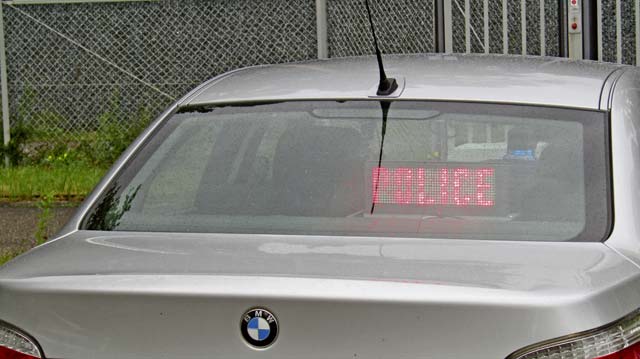
When instructing drivers to pull over, unmarked polizei cars will illuminate blue lights in the front and rear windows and a digital screen will display the following messages: STOP, POLIZEI, BITTE FOLGEN >>>>>>>>>>>. (STOP, POLICE, PLEASE FOLLOW). American drivers are required to comply with polizei instructions when given.
German polizei use unmarked traffic cars just like traffic-enforcement officers in the United States. So why don’t some American drivers stop when an unmarked polizei car pulls ahead with flashing lights?
It’s important for drivers to pull over when told to do so by marked or unmarked polizei vehicles, said Lt. Col. Steven Kane, U.S. Army Garrison Rheinland-Pfalz director of Emergency Services.
“Drivers need to obey polizei instructions for safety reasons,” the DES director explained. “Don’t try to out run unmarked polizei cars or bypass them — you’ll just get in more trouble and incur more fines. Cooperating with the polizei is not only the right thing to do — it’s the law.”
A police officer has only seconds to decide how to further handle the situation when a driver doesn’t stop when directed, explained Karin Decker, Polizeipraesidium Westpfalz.
“The officer needs to complete the required action — a traffic stop. Therefore it is important to inform the American community that they must follow orders and signals from a polizei officer — even if the car is unmarked,” she said.
So how would drivers know if an unmarked car is a legitimate polizei vehicle?
Decker explained that when a polizei officer establishes that a traffic violation has occurred, the unmarked car will illuminate blue lights in the front and rear windows and pull in front of the affected vehicle. A digital screen will display the following messages: STOP, POLIZEI, BITTE FOLGEN, >>>>>>>>>>>. (STOP, POLICE, PLEASE FOLLOW). At that point, the affected vehicle must immediately comply with directions to pull over, she said.
Even with flashing lights and digital displays instructing vehicles to pull over in English and German, some U.S. drivers don’t stop, which leads to a negative situation for the officers, she said.
“The officer then has to reassess the situation and decide which course of action to take,” Decker explained. “Unfortunately, U.S. drivers don’t always believe the unmarked car is a ‘real’ police car and don’t stop. When some U.S. drivers do stop, they distrust the actual offense they are being accused of and the on-the-spot fine.”
So how will American drivers know a plain clothes polizei officer driving an unmarked car is legitimate?
Decker said polizei officers will present their identification cards to drivers and let them know of the road offense(s) that were committed. Typically, an on-the-spot fine will be issued and a receipt will be provided to the driver, showing the officer’s name and assigned station. When drivers don’t stop, the fine will increase in 70 euro increments and lose one point on his or her driver’s license, she added.
Unlike the U.S., Decker said there haven’t been any incidents of criminals posing as polizei officers, but if there is a reasonable suspicion that an unmarked car may not be a polizei vehicle and the stretch of road is desolate, motorists should look for the nearest populated, well-lit area to pull over, such as a rest stop or gas station for safety.


